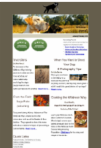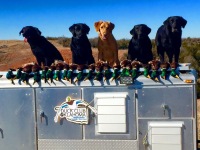By Guy Billups, Wildrose Texas
Let’s begin with a short checklist of essential field skills required for a successful pheasant hunt with your retriever.
Will your flushing retriever …
- Heel off-lead around high distractions, such as other running dogs, birds flying and running, gunfire both with hits and missing a bird…a fly away?
- Retrieve downed large birds, such as pheasants, to hand without damage?
- Hunt cover for unseens and readily stops to the whistle and take directional casts?
- Remain steady to flush while quartering and cover the ground thoroughly in search of birds while remaining close to the shooters?

Each of these skills should be entrenched to the point of habit and have been demonstrated reliably for a year.
Patience is always a virtue and its virtue cannot be underestimated in dog training. Taking dogs too early to the hunting field or into situations they are not prepared for is a recipe for disaster and will require a great deal of time trying to “fix” created problems.
The Wildrose Way five-option drill is one of the lessons I do often when preparing my dogs for the North Dakota trip or any walk-up pheasant shooting. I like to do a lot of different variations of this drill to accomplish an entire array of skills. For review of the five-option drill, see Sporting Dogs and Retriever Training, the Wildrose Way or our Upland Training DVD, both available at wildrosetradingcompany.com.

Early on in training, once I have a dog stopping to the whistle at heel reliably, I release them to air out (potty or free run shortly). I then blow the sit whistle and when they sit, I toss a bumper. At first they may break for the bumper, which cannot be allowed to continue but initially I want the quick sit reaction to the stop whistle, even when distracted and paying attention to other things like free running and exploring close by.
This activity’s purpose is two-fold, one it keeps the dog close and engaged with you even when letting the dog exercise or air out, and it also entrenches a quick whistle stop response and sit to the flush of the eventual flushed bird.

Later, you will develop further options of picking up the bumper as a denial:
- having another dog pick the bumper,
- recalling the dog then sending for a bumper or another unseen or memory bird,
- going out to the dog and lining for the retrieve,
- or even sending your dog remotely for the thrown bumper.
Then we advance to tall grass, birds, and definitely gunfire before we make the trek North.
Good luck, and feel free to reach out with questions, guy@uklabs.com.



